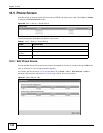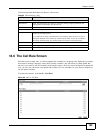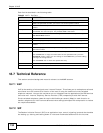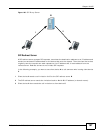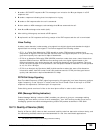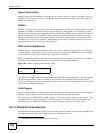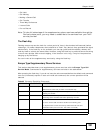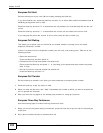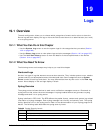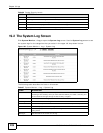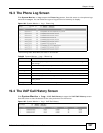
Chapter 18 VoIP
FMG3024-D10A / FMG3025-D10A Series User’s Guide
200
Type of Service (ToS)
Network traffic can be classified by setting the ToS (Type of Service) values at the data source (for
example, at the Device) so a server can decide the best method of delivery, that is the least cost,
fastest route and so on.
DiffServ
DiffServ is a class of service (CoS) model that marks packets so that they receive specific per-hop
treatment at DiffServ-compliant network devices along the route based on the application types
and traffic flow. Packets are marked with DiffServ Code Points (DSCP) indicating the level of service
desired. This allows the intermediary DiffServ-compliant network devices to handle the packets
differently depending on the code points without the need to negotiate paths or remember state
information for every flow. In addition, applications do not have to request a particular service or
give advanced notice of where the traffic is going.
2
DSCP and Per-Hop Behavior
DiffServ defines a new DS (Differentiated Services) field to replace the Type of Service (TOS) field
in the IP header. The DS field contains a 2-bit unused field and a 6-bit DSCP field which can define
up to 64 service levels. The following figure illustrates the DS field.
DSCP is backward compatible with the three precedence bits in the ToS octet so that non-DiffServ
compliant, ToS-enabled network device will not conflict with the DSCP mapping.
Figure 102 DiffServ: Differentiated Service Field
The DSCP value determines the forwarding behavior, the PHB (Per-Hop Behavior), that each packet
gets across the DiffServ network. Based on the marking rule, different kinds of traffic can be
marked for different priorities of forwarding. Resources can then be allocated according to the DSCP
values and the configured policies.
VLAN Tagging
Virtual Local Area Network (VLAN) allows a physical network to be partitioned into multiple logical
networks. Only stations within the same group can communicate with each other.
Your Device can add IEEE 802.1Q VLAN ID tags to voice frames that it sends to the network. This
allows the Device to communicate with a SIP server that is a member of the same VLAN group.
Some ISPs use the VLAN tag to identify voice traffic and give it priority over other traffic.
18.7.4 Phone Services Overview
Supplementary services such as call hold, call waiting, and call transfer. are generally available from
your VoIP service provider. The Device supports the following services:
2. The Device does not support DiffServ at the time of writing.
DSCP
(6-bit)
Unused
(2-bit)



